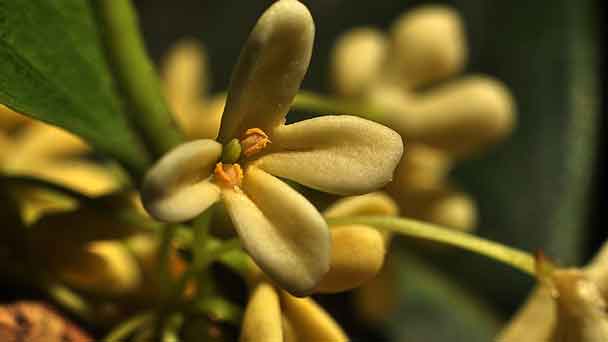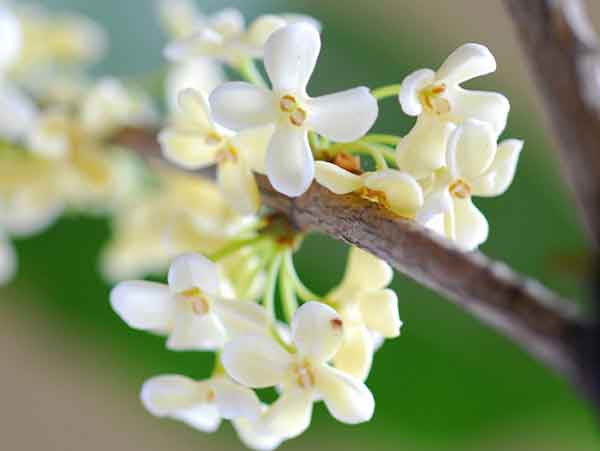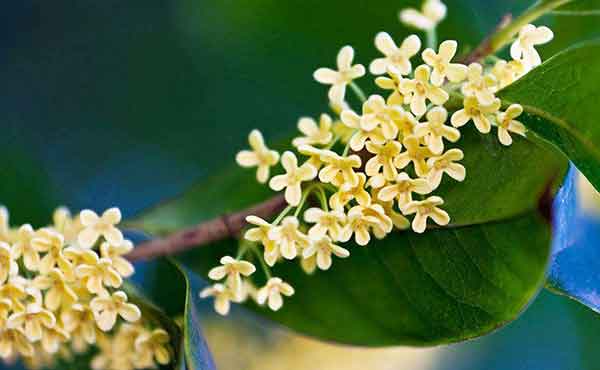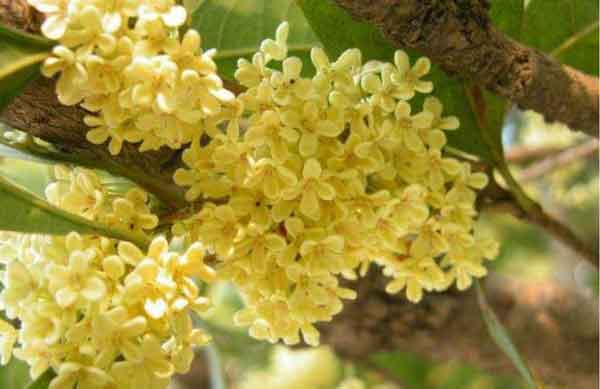Tea Olive Tree (Osmanthus Fragrans) Care & Propagation Guide
Written by Iris
Nov 19 2022

If you want a pleasant scent, easy maintenance, and good looks for your Tea Olive tree. With our care instructions, you'll be well on your way to adding a few Tea Olives to your landscape.
Tea olive tree (Osmanthus fragrans), native to east central Asia, is 10 to 15 feet tall and wide in most landscape cases. Tea olive shrub is best suited for USDA plant hardtolerance zones 8B to 11. Often used as a pruned hedge or building base plant, Tea olive shrub has evergreen oval leaves. From early fall to spring, small white or gold flowers give off a pleasant aroma. Sporadic, fragrant flowers continue throughout the summer.
Read More:
How To Grow Tea Olive Tree In Container?
Read More:
How To Propagate Tea Olive Tree?
Read More:
12 Wonderful Evergreen Shrubs for Your Garden
Osmanthus ×fortunei (Fortune's osmanthus, Zones 7 - 9) is a hybrid of O. heterophyllus and Osmanthus fragrans and has characteristics of both parents. Juvenile leaves are spine-tipped, but the adult leaves have no marginal spines. Fragrant flowers bloom in late fall, and it can grow into a large oval to rounded shrub 15 to 20 feet high and wide. (Read more about Tea Olive Tree Blooming.)
Osmanthus ×burkwoodii (Burkwood osmanthus, Zones 6 - 8) is a dense, rounded shrub that grows 6 to 10 feet tall and wide. This evergreen shrub bears fragrant flowers characteristic of the genus.
Osmanthus delavayi (Delavay osmanthus, Delavay tea olive; Zones 7 - 9) is native to western China and grows 6 to 8 feet tall and a bit wider. It has twiggy growth and graceful arching branches that are well covered with small, glossy, dark green, ovate leaves. Fragrant flowers bloom in spring, and it is more widely grown in the western states since it prefers alkaline soil.
Osmanthus serrulatus (wild sweet-scented Chinese osmanthus, Zones 7 - 9) grows 6 to 12 feet tall, bears fragrant flowers, and is a slow-growing broadleaf evergreen shrub. Leaves are lustrous, leathery textured, and strongly serrate. On mature plants they may become entire and loose their toothed edges.
Osmanthus suavis (Himalayan osmanthus, Zones 7 - 10) is more upright than other Osmanthus species, and tends to be a bit leggier. In late winter to early spring, however, it is literally covered with clusters of white, fragrant flowers. Osmanthus decorus is another species that is evergreen and bears fragrant flowers. It seems to be less well-known than other species.
Osmanthus yunnanensis (Yunnan osmanthus, Zones 8 - 10) grows up to about 33 feet tall, so it one of the largest of the genus. Ivory-white, mildly fragrant flowers are almost hidden from view by the large, olive-green, leathery leaves. Although rarely cultivated in the United States, Woodlanders Nursery lists it for sale on their site.
Read More:
Tea olive tree (Osmanthus fragrans), native to east central Asia, is 10 to 15 feet tall and wide in most landscape cases. Tea olive shrub is best suited for USDA plant hardtolerance zones 8B to 11. Often used as a pruned hedge or building base plant, Tea olive shrub has evergreen oval leaves. From early fall to spring, small white or gold flowers give off a pleasant aroma. Sporadic, fragrant flowers continue throughout the summer.
How to Propagate Tea Olive TreePropagate Tea Olive Tree with SeedsPropagate Tea Olive Tree with CuttingsHow to Care for Tea Olive TreeTea Olive Tree LightingTea Olive Tree Soil CareTea Olive Tree WateringTea Olive Tree Temperature & Humidity CareTea Olive Tree FertilizerTea Olive Tree PruningTea Olive Tree Pests & Diseases CareVarieties of Tea Olive TreeTea Olive Tree Care FAQHow Big Do Tea Olive Tree Get?Is Tea Olive Tree Poisonous?What Does Tea Olive Smell Like?How Fast Do Tea Olive Tree Grow?
How to Propagate Tea Olive Tree
Propagate Tea Olive Tree with Seeds
Fill a container with seed starting mix to about ½ inch from the top. Place your tea olive tree seeds 1 inch to 1 ½ inches below the soil surface. Gently water your seeds to keep moist, not soaking wet. Heat & humidity is critical for germination. Germination may occur in 1 week or as long as 3 months (depending on the species). Place the seed container on a heat mat under growing light(s). Keep your growing lights on 14 hours per day. Keep your heat mat on 24 hours per day. Once your seeds germinate, move each seed into its own container under the growing lights and on the heat mat. Keep your seedlings indoors for 2-3 months before transplanting outdoors in the spring (May to June).Read More:
How To Grow Tea Olive Tree In Container?
Propagate Tea Olive Tree with Cuttings
Tea olive tree may be propagated from new growth. Mix equal portions of potting soil, sand and peat (or Perlite) in a small container. Start with an 8-inch pot. Using sharp clippers, cut several shoots of new growth from the shrub. Remove all leaves from the bottom 2-inches of each shoot. Rough up the bottom of each shoot (this will make it easier for roots to develop). Gather three of the shoots together (as if making a bouquet) and place them in the container of soil. Water well. Set the pot outside in the sun (preferably near a water source). The stems must stay moist for a root system to develop. In a couple of months, pull gently at the plant. If the plant resists, then roots have established. Move the plant up to a pot that is one size larger. Allow the tiny tea olive shrub to grow for a few months and then transfer to a container that is one size larger. Continue this same operation until the plant has been moved up to a 3-gallon container. Allow the shrub to grow for several months in the container before transplanting into your landscape.Read More:
How To Propagate Tea Olive Tree?

How to Care for Tea Olive Tree
Tea Olive Tree Lighting
Plant your Tea olive in an area of your garden that is sunny or partially shaded. Your Tea olive is somewhat resilient to varying conditions, but it will not thrive in fully shaded locations. Most tea olive shrubs enjoy full sun to part shade. In especially warm climates, the Tea olive will grow best with afternoon shade to offer protection from hot, direct sunlight. Once established, these evergreen Tea olive shrubs will tolerate clay soil and drought but perform best in moist but well-drained fertile and acidic soil.Read More:
12 Wonderful Evergreen Shrubs for Your Garden
Tea Olive Tree Soil Care
Tea olive tree aren't too picky about soil type, but they do prefer a well-drained soil of average fertility. As with so many other types of ornamental plants, constantly soggy or wet soil can cause root rot and other harmful plant diseases. So make sure to plant your tea olive in a well-drained site. tea olive trees grow best in an acid to slightly alkaline soil ranging between 5.5 to 7.5 on the pH scale. Most average garden soils fall between a pH range of 6.0 to 7.0.Tea Olive Tree Watering
These shrubs are fairly drought tolerant and should not need extra watering unless there is an unusually dry spring or summer. And most of the reasons why tea olive trees drop leaves are caused by improper watering.Tea Olive Tree Temperature & Humidity Care
Since they grow best in warm zones, Tea olive can tolerate high temperatures and humidity. Tea olive trees are not suited for arid or desert climates, however, as they prefer the humid air found in the southeastern states.Tea Olive Tree Fertilizer
Tea olive will benefit from fertilization. You can fertilize Tea Olive tree in spring with a slow-release shrub & tree food, preferably one that contains Sulfur and/or Iron. Alternatively, you can feed with a natural organic plant food. To avoid stimulating new growth that could be damaged by an early frost, cease fertilization two weeks prior to the average first frost date in your area.Tea Olive Tree Pruning
Prune away dead, damaged or diseased branches from Tea olive shrub any time of year. Use sharp bypass pruning shears, and wear gloves and safety goggles when you prune. Make cuts 1/4 to 1/2 inch above a lower branch junction or leaf. To prevent the spread of disease, sterilize pruner blades with household disinfectant before and after you prune your tea olive tree.Tea Olive Tree Pests & Diseases Care
Tea olive tree really will have little problems to worry about if planted and cared for properly. They are long-lived and virtually pest free. Occasional disease and insect problems could occur but this would be mainly when the plant is under stressful conditions becoming more prone to pest problems. Root rot disease could occur but will be associated with the plant being planted in poorly drained or excessively wet soils. Occasionally, scale insects could be a problem but can be managed well with horticultural oil spray. A bonus for tea olive tree is that they are fairly resistant to damage by deer.
Varieties of Tea Olive Tree
Osmanthus heterophyllus (holly tea olive, false holly, or holly osmanthus; Zones 7 - 9) is used in borders, hedges and barrier plantings where its extremely spiny leaves can be utilized. Several cultivars are available in various sizes and leaf characteristics that may be better choices for many landscapes.Osmanthus ×fortunei (Fortune's osmanthus, Zones 7 - 9) is a hybrid of O. heterophyllus and Osmanthus fragrans and has characteristics of both parents. Juvenile leaves are spine-tipped, but the adult leaves have no marginal spines. Fragrant flowers bloom in late fall, and it can grow into a large oval to rounded shrub 15 to 20 feet high and wide. (Read more about Tea Olive Tree Blooming.)
Osmanthus ×burkwoodii (Burkwood osmanthus, Zones 6 - 8) is a dense, rounded shrub that grows 6 to 10 feet tall and wide. This evergreen shrub bears fragrant flowers characteristic of the genus.
Osmanthus delavayi (Delavay osmanthus, Delavay tea olive; Zones 7 - 9) is native to western China and grows 6 to 8 feet tall and a bit wider. It has twiggy growth and graceful arching branches that are well covered with small, glossy, dark green, ovate leaves. Fragrant flowers bloom in spring, and it is more widely grown in the western states since it prefers alkaline soil.
Osmanthus serrulatus (wild sweet-scented Chinese osmanthus, Zones 7 - 9) grows 6 to 12 feet tall, bears fragrant flowers, and is a slow-growing broadleaf evergreen shrub. Leaves are lustrous, leathery textured, and strongly serrate. On mature plants they may become entire and loose their toothed edges.
Osmanthus suavis (Himalayan osmanthus, Zones 7 - 10) is more upright than other Osmanthus species, and tends to be a bit leggier. In late winter to early spring, however, it is literally covered with clusters of white, fragrant flowers. Osmanthus decorus is another species that is evergreen and bears fragrant flowers. It seems to be less well-known than other species.
Osmanthus yunnanensis (Yunnan osmanthus, Zones 8 - 10) grows up to about 33 feet tall, so it one of the largest of the genus. Ivory-white, mildly fragrant flowers are almost hidden from view by the large, olive-green, leathery leaves. Although rarely cultivated in the United States, Woodlanders Nursery lists it for sale on their site.

Tea Olive Tree Care FAQ
How Big Do Tea Olive Tree Get?
Although it's considered a slow to moderate grower – four to 12 inches a year – soil quality and pruning can greatly affect that. Depending on the species and cultivarof Tea olive tree (Osmanthus fragrans), some types reach only six feet while others can tower up to 30 feet. Because of their natural growth habit, tea olives don't require pruning.Is Tea Olive Tree Poisonous?
There is no evidence to suggest that any part of the olive tree (Olea europaea) is poisonous to animals. Tea olive tree grow in the warm climates of U.S. Department of Agriculture plant hardiness zones 8 through 10.What Does Tea Olive Smell Like?
In fact, osmanthus (sometimes referred to as tea olive) has a distinctive fruity aroma. It smells a lot like peach and apricot. Often, Tea olive tree (Osmanthus fragrans) is used to blend fruity and floral notes together in a sweet, natural way. Tea olives trees are some of the most sweetly fragrant plants in Southern gardens.How Fast Do Tea Olive Tree Grow?
Tea olive tree grows at a medium rate, with height increases of 13–24" per year.Read More:
Latest Updated
- Benefits of Bugleweed - 7 Science-backed Health Benefits
- Bugleweed Dangers & Side Effects - Is It Poisonous?
- How to Plant Evergreen Trees - What You Should Know
- When to Plant Evergreens - Grow Guide for Evergreen Trees
- 12 Wonderful Evergreen Shrubs for Your Garden
- 12 Popular Evergreen Plants with Pictures for Beginners
- When And How To Prune A Lilac Bush Like a Pro
- How to Grow & Care for Lilac Vine (Hardenbergia Violacea)
- Japanese Lilac Tree (Syringa Reticulata) Care & Propagation Guide
- Shumard Oak Pros and Cons - What to Know
Popular Articles
- Winter maintenance of Antirrhinum Majus
- How to Grow Terminalia Mantaly Tree
- How to Grow and Care for Crossostephium Chinense
- How to grow Antirrhinum Majus in spring
- Peristeria Elata (Dove Orchid) Profile: Info & Care Guide
- Underwatered Snake Plant (Sansevieria Trifasciata) - Signs And How To Fix
- How to Care for Brazilian Jasmine Plant (Mandevilla Sanderi)
- How to Grow & Care for Graptopetalum Purple Delight in Summer
- Rosa Chinensis (China Rose): Plant Growing & Care Tips
- How to Care for Baby Sun Rose (Aptenia Cordifolia)